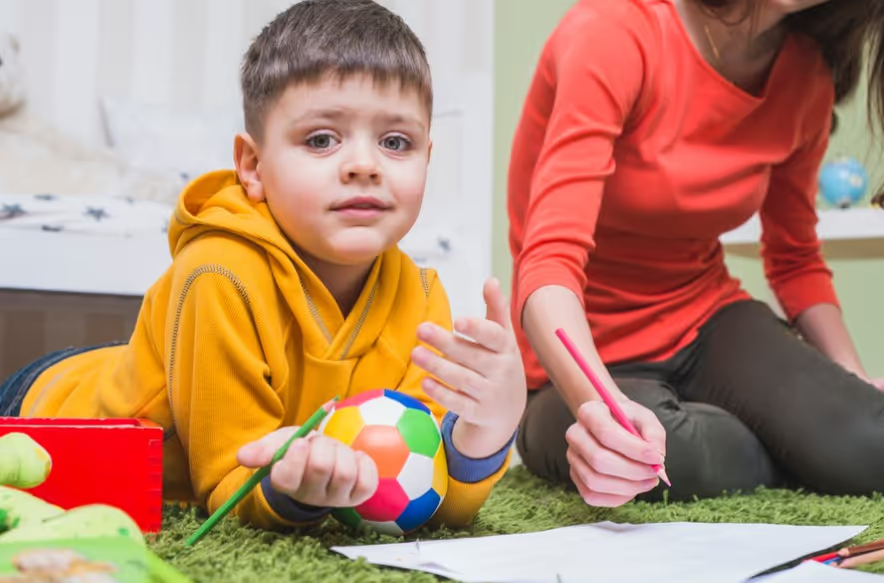What Is Play Therapy For Autism?

Understanding Autism Spectrum Disorder
Autism spectrum disorder, commonly referred to as ASD, is a complex condition that impacts an individual's social skills, communication abilities, and behaviors. To understand the potential benefits of play therapy for autism, it is important first to comprehend the nature of autism itself.
Core Characteristics of Autism
Autism is characterized by a range of symptoms, which can vary in severity. The core characteristics of autism include social deficits, language impairment, and repetitive and restricted behaviors. Children with ASD often face difficulty in comprehension and exhibit atypical sensory processing, which can lead to challenges in their play skills.
Children with ASD typically exhibit limitations in adaptive behavior and prefer solitary play. They often engage in repetitive behaviors and may struggle with symbolic and imaginative play. These characteristics can make it challenging for children with ASD to interact with their peers and form relationships.

Challenges in Social Interaction
One of the main challenges faced by individuals with autism is navigating social interactions. Due to their difficulties with communication and understanding social cues, children with ASD often find it hard to relate to others in neurotypical ways. This can result in feelings of isolation and can hamper their ability to form meaningful relationships.
Play therapy is a form of intervention that is designed to help children with autism overcome these challenges. Through play therapy, children with ASD can learn to move beyond self-absorption into shared interactions. This allows them to explore their feelings, their environment, and their relationships with others in a safe and supportive setting.
By understanding the core characteristics of autism and the associated challenges in social interaction, we can better appreciate the potential value of play therapy for individuals with ASD. In the following sections, we will delve deeper into the benefits of play therapy and explore how it can help children with autism develop their social and communication skills, improve their emotional well-being, and expand their play repertoire.
Importance of Play Therapy for Autism
When discussing autism therapies, an essential approach that plays a significant role in child development is play therapy. But what is play therapy for autism? It's a form of psychotherapy that utilizes play as a means of communication to help children express their emotions, needs, and thoughts in a safe, fun environment.
Benefits of Play Therapy
Play therapy has several benefits for children with autism. It's primarily designed to help them engage in play activities of their interest and choice, acting as a vehicle for them to express themselves comfortably. This form of therapy aims to prevent or resolve psychosocial difficulties and achieve optimal child growth and development.
By changing their way of self-expression from unwanted behaviors to more non-injurious expressive behavior using toys or activities of their choice, play therapy helps children with autism experience various interaction styles.
Some of the key benefits of play therapy for autism include:
- Development of social skills
- Improvement in communication
- Reduction of problem behaviors
- Expression of emotions and feelings in a non-verbal way
- Provision of a comfortable platform to communicate experiences without having to use words or verbalize complex thoughts (Total Care ABA)
Role of Play in Child Development
Play is not just about fun and games; it's a vital part of child development. It provides a platform for children to explore their environment, learn new skills, and interact with others. For children with autism, play serves as an effective tool to help them cope with challenges and reach their full potential.
In the context of play therapy, play becomes a therapeutic medium that helps children with autism express themselves, understand their emotions, and navigate social interactions. It's a natural way for children to communicate, making it an excellent method for them to articulate complex thoughts and feelings.
Additionally, play therapy also aids in emotional regulation and problem-solving, equipping children with autism with essential skills that they can apply in their daily life. By fostering a supportive and enjoyable environment, play therapy makes the learning process more engaging and effective for children with autism.
Understanding the benefits and role of play in child development can guide parents and caregivers in choosing the best therapeutic approach for their children. Play therapy, with its numerous benefits, proves to be a significant method in helping children with autism reach their full potential.
Types of Play Therapy for Autism
Addressing the question, 'what is play therapy for autism?', involves understanding the different types of play therapies that are used as interventions for children with Autism Spectrum Disorder (ASD). Two of the most effective approaches are Child-Centered Play Therapy and Floor Time-Play Therapy.
Child-Centered Play Therapy
Child-centered play therapy is a promising intervention for enhancing emotional and social behaviors in children with ASD. This therapy becomes an integral part of an overall treatment approach that also includes behavioral techniques and parental training. The primary goals of child-centered play therapy are:
- Improving parent education and training
- Enhancing the child's social skills
- Correcting maladaptive behavior
- Boosting overall functioning of the child
Child-centered play therapy, and its sibling approach, child-led play therapy, aim to engage children in play activities. These activities are designed to enhance emotional and social behaviors, as well as improving social communication skills in children with ASD.
This form of therapy has been shown to significantly reduce ASD core symptoms and behavioral disorders in children with autism. It is a relationship-based intervention that allows the therapist to enter the child's world and use the built relationship to intervene rather than train the child.
Floor Time-Play Therapy
Floor time-play therapy, another type of play therapy for children with autism, is designed to be versatile and can be done at home or in a therapist's office. This therapy involves the therapist or caregiver sitting on the floor to play with the child according to the child's own terms. The ultimate goal is to help the child focus their thinking, improve their emotional skills, and expand their communication circles [1].
Floor time play therapy can help the child to improve on various critical developmental milestones. This form of therapy provides two-way communication that may progress to more complex communication. It fosters creative thinking and emotional thinking, allows the child to enjoy intimacy, and encourages engagement in relationships. The ultimate benefits of floor time-play therapy include:
- Improved self-regulation
- Enhanced emotional and intellectual growth
- Enhanced interest in the world
By understanding these types of play therapy for autism, parents, caregivers, and therapists can better support children with ASD and help them develop essential social and emotional skills. This is a crucial part of their journey towards leading fulfilling and productive lives.
Techniques in Play Therapy
When answering the question, 'what is play therapy for autism?', it's vital to understand the techniques used. Two key techniques in play therapy involve the use of sensory toys and the focus on building communication skills.
Using Sensory Toys
Sensory toys play an integral role in play therapy for children with autism. These toys are designed to stimulate a child's five senses: sight, sound, touch, smell, and taste, and help them develop their senses in a safe and natural environment through play [4].
Moreover, these sensory toys help children with autism relax, focus, and calm down, aiding them in grasping objects with decreased fear and discomfort. This ultimately helps them engage in play more naturally.
Some examples of sensory toys preferred by children with autism include weighted stuffed animals, fidget toys, and putty. These toys help calm the children and encourage them to engage their senses positively during play.
For instance, sensory reflective balls can help children with autism develop their visual sense. This is beneficial as studies have shown that children with ADHD and autism may have difficulty processing visual sensory information.
Building Communication Skills
Another paramount technique in play therapy for autism is the focus on building communication skills. Play therapy for autism often utilizes various techniques and approaches, including the Floortime method and sensory-based play therapy.
The Floortime method involves active participation from parents, encouraging engagement and social interaction, while sensory-based play therapy uses sensory toys to stimulate a child's senses and promote sensory integration [5].
These techniques not only facilitate play but also foster the development of essential communication skills. By interacting with their environment and others around them during play, children with autism can enhance their ability to express themselves, understand others, and engage in social interactions.
Through the use of sensory toys and a focus on building communication skills, play therapy can provide a supportive and engaging environment for children with autism to grow and thrive.
Implementing Play Therapy
Once understanding what play therapy for autism is, the next step involves implementation. This process includes working with specialists and integrating play therapy into daily life.
Working with Specialists
Play therapy, as a non-threatening and non-intrusive form of therapy, involves a range of activities to help children with autism. It is a customized approach that adapts to the specific needs of each child, engaging them in fun and interactive activities that facilitate their development in a safe environment.
The implementation of play therapy should ideally be under the guidance of a trained therapist. These specialists are experienced in navigating the unique challenges that children with autism face. They can tailor therapy sessions to the child's interests and needs, utilizing toys or activities of choice as tools for expression.
Play therapy can be conducted one-on-one with a therapist, or in small groups, offering opportunities for social skill practice and peer learning. It provides a holistic approach that focuses on the unique needs of each child, promoting their overall development and well-being.
Play Therapy in Daily Life
In addition to structured sessions with a therapist, elements of play therapy can also be integrated into a child's daily life. This involves creating an environment at home where the child feels comfortable expressing themselves through play.
Parents and caregivers can encourage children with autism to engage in play activities of their interest and choice. This approach helps to prevent or solve psychosocial difficulties and achieve optimal child-healthy growth and development [1].
Moreover, the use of toys or activities that the child enjoys can help transition them from unwanted behaviors to more non-injurious expressive behavior. It can also help them experience various interaction styles, enhancing communication and social skills.
Implementing play therapy in daily life requires patience, understanding, and creativity. It's important to remember that each child is unique, and the activities that work for one child may not work for another. With time and consistent effort, play therapy can help children with autism improve their social interactions, manage challenging behaviors, and express themselves in healthier ways.
Research and Evidence on Play Therapy
In the realm of autism treatment, play therapy has emerged as a beneficial approach to aid children in their growth and development. The effectiveness of this treatment method is supported by various studies, and ongoing research continues to uncover more about its impact.
Effectiveness of Play Therapy
Play therapy is primarily intended to assist children with autism in engaging in activities of their interest and choice, providing a comfortable method for expressing themselves. It aims to alleviate or solve psychosocial difficulties and achieve optimal child-healthy growth and development.
Approaches such as child-centered play therapy and child-led play therapy, which focus on encouraging children to participate in play activities, have been found effective in improving social communication skills and enhancing emotional and social behaviors in children with Autism Spectrum Disorder [1].
Play therapy for autism, as a form of psychotherapy, uses play as a communication tool to help children express their emotions, needs, and thoughts. It provides a secure and enjoyable environment for children to learn and develop essential skills necessary for social interaction, emotional regulation, and problem-solving [3].
Ongoing Studies and Findings
As research in this area progresses, more evidence supporting the benefits of play therapy for children with autism continues to surface. Studies have shown that this approach can help children develop social skills, enhance their communication capabilities, and reduce problem behaviors. As a result, it's an effective way to help children with autism manage challenges and reach their full potential [3].
Moreover, play therapy offers a valuable medium for children with autism to express their emotions and feelings in a non-verbal manner. By participating in play activities, they can comfortably communicate their experiences without having to use words or articulate complex thoughts [3].
While the current body of research provides strong support for the effectiveness of play therapy in treating autism, more studies are underway to further explore its potential benefits and applications. The continuous advancements in this field promise to yield more insights into the impact of play therapy on the development and wellbeing of children with autism in the years to come.
References
[1]: https://www.ncbi.nlm.nih.gov/pmc/articles/PMC9850869/
[2]: https://www.verywellhealth.com/play-therapy-and-autism-the-basics-260059
[4]: https://carmenbpingree.com/blog/best-sensory-toys-for-children-with-autism/
[5]: https://www.yellowbusaba.com/post/what-is-play-therapy-for-autism
Recent articles

How to Prepare Your Child for ABA Therapy
Empowering Your Child for a Successful Start in ABA Therapy

The Connection Between ABA Therapy and Improved Family Dynamics
Enhancing Family Bonds Through ABA Therapy: A Holistic Approach

The Importance of Routine and Structure in ABA Therapy
How Routine and Structure Transform Autism Therapy

The Role of ABA Therapy in Teaching Money and Time Management Skills
Empowering Independence Through Behavioral Strategies

How to Prepare Your Child for ABA Therapy Sessions
Preparing Your Child for a Positive ABA Experience: Essential Tips for Parents

The Role of Functional Communication Training in Autism Therapy
Transforming Autism Care with Effective Communication Strategies


